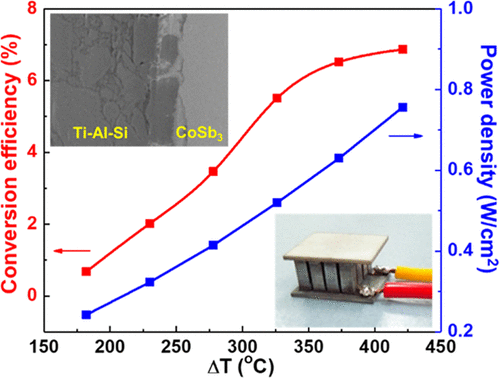当前位置:
X-MOL 学术
›
ACS Appl. Mater. Interfaces
›
论文详情
Our official English website, www.x-mol.net, welcomes your
feedback! (Note: you will need to create a separate account there.)
Enhanced Interfacial Reliability and Mechanical Strength of CoSb3-Based Thermoelectric Joints with Rationally Designed Diffusion-Barrier Materials of Ti-Based Alloys.
ACS Applied Materials & Interfaces ( IF 8.3 ) Pub Date : 2020-09-14 , DOI: 10.1021/acsami.0c14180 Junqin Li 1 , Shiyuan Zhao 1 , Jiali Chen 1 , Guangyuan Bai 1 , Lipeng Hu 1 , Fusheng Liu 1 , Weiqin Ao 1 , Yu Li 1 , Heping Xie 2 , Chaohua Zhang 1
ACS Applied Materials & Interfaces ( IF 8.3 ) Pub Date : 2020-09-14 , DOI: 10.1021/acsami.0c14180 Junqin Li 1 , Shiyuan Zhao 1 , Jiali Chen 1 , Guangyuan Bai 1 , Lipeng Hu 1 , Fusheng Liu 1 , Weiqin Ao 1 , Yu Li 1 , Heping Xie 2 , Chaohua Zhang 1
Affiliation

|
To achieve high-performance thermoelectric (TE) devices, constructing a good interfacial connection between TE materials and electrodes is as important as having high figure-of-merit TE materials. Although CoSb3-based TE devices have received great attention for power generation recently, the limited long-term service stability is the main obstruct for their applications. In this work, we have prepared two kinds of Ti-based alloys (Ti83.7Al10.7Si5.6 and Ti74Ni26) as the diffusion barrier layer of CoSb3-based TE joints by the spark plasma sintering method and have systematically investigated their interfacial behaviors during the aging process. The performances of contact resistivity and mechanical strength for Ti74Ni26/Yb0.4Co3.8Fe0.2Sb12 TE joints are good before aging treatment but gradually deteriorate during the aging process, which should be ascribed to the phase-transition-induced negative thermal expansion in Ti–Ni alloys. On the other hand, Ti83.7Al10.7Si5.6/Yb0.4Co3.8Fe0.2Sb12 TE joints show both low contact resistivity (<10 μΩ·cm2) and high mechanical strength (>20 MPa) before and after 16-day aging at 500 °C, which is originated from the matching of the coefficient of thermal expansion (CTE) and the formation of network structures in Ti–Al–Si alloys. We have also prepared an eight-couple TE module of p-Ge0.9Sb0.1TeB0.01/n-Yb0.4Co3.8Fe0.2Sb12 and have measured its corresponding device performance. Our work has demonstrated that the matched CTE and network structures in the Ti–Al–Si alloy are key to obtain high-performance CoSb3-based TE joints for long-term service.
中文翻译:

合理设计的钛基合金扩散阻挡层材料提高了CoSb3基热电接头的界面可靠性和机械强度。
为了获得高性能的热电(TE)器件,在TE材料和电极之间建立良好的界面连接与具有高品质因数的TE材料一样重要。尽管基于CoSb 3的TE器件最近在发电领域受到了广泛关注,但长期的服务稳定性有限是其应用的主要障碍。在这项工作中,我们准备了两种Ti基合金(Ti 83.7 Al 10.7 Si 5.6和Ti 74 Ni 26)作为CoSb 3的扩散阻挡层火花等离子体烧结法制备基于基体的TE接头,并系统地研究了它们在时效过程中的界面行为。Ti 74 Ni 26 / Yb 0.4 Co 3.8 Fe 0.2 Sb 12 TE接头的接触电阻率和机械强度性能在时效处理之前是良好的,但在时效过程中会逐渐劣化,这应归因于相变引起的负热Ti-Ni合金的膨胀。另一方面,Ti 83.7 Al 10.7 Si 5.6 / Yb 0.4 Co 3.8 Fe 0.2 Sb 12TE接头在500°C下老化16天之前和之后均显示出低接触电阻率(<10μΩ·cm 2)和高机械强度(> 20 MPa),这是由于热膨胀系数(CTE)匹配所致)和Ti-Al-Si合金中网络结构的形成。我们还准备了p-Ge 0.9 Sb 0.1 TeB 0.01 / n-Yb 0.4 Co 3.8 Fe 0.2 Sb 12的八耦合TE模块,并测量了其相应的器件性能。我们的工作表明,Ti-Al-Si合金中匹配的CTE和网络结构是获得可长期使用的高性能CoSb 3基TE接头的关键。
更新日期:2020-10-07
中文翻译:

合理设计的钛基合金扩散阻挡层材料提高了CoSb3基热电接头的界面可靠性和机械强度。
为了获得高性能的热电(TE)器件,在TE材料和电极之间建立良好的界面连接与具有高品质因数的TE材料一样重要。尽管基于CoSb 3的TE器件最近在发电领域受到了广泛关注,但长期的服务稳定性有限是其应用的主要障碍。在这项工作中,我们准备了两种Ti基合金(Ti 83.7 Al 10.7 Si 5.6和Ti 74 Ni 26)作为CoSb 3的扩散阻挡层火花等离子体烧结法制备基于基体的TE接头,并系统地研究了它们在时效过程中的界面行为。Ti 74 Ni 26 / Yb 0.4 Co 3.8 Fe 0.2 Sb 12 TE接头的接触电阻率和机械强度性能在时效处理之前是良好的,但在时效过程中会逐渐劣化,这应归因于相变引起的负热Ti-Ni合金的膨胀。另一方面,Ti 83.7 Al 10.7 Si 5.6 / Yb 0.4 Co 3.8 Fe 0.2 Sb 12TE接头在500°C下老化16天之前和之后均显示出低接触电阻率(<10μΩ·cm 2)和高机械强度(> 20 MPa),这是由于热膨胀系数(CTE)匹配所致)和Ti-Al-Si合金中网络结构的形成。我们还准备了p-Ge 0.9 Sb 0.1 TeB 0.01 / n-Yb 0.4 Co 3.8 Fe 0.2 Sb 12的八耦合TE模块,并测量了其相应的器件性能。我们的工作表明,Ti-Al-Si合金中匹配的CTE和网络结构是获得可长期使用的高性能CoSb 3基TE接头的关键。











































 京公网安备 11010802027423号
京公网安备 11010802027423号